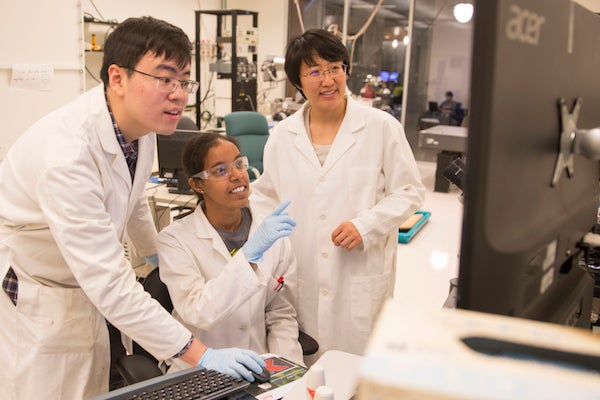Some of our most vital biological functions rely on the body’s natural ability to gather up specific types of molecules, and then move and distribute them to organs and other internal locations where they’re needed.
Basic cell growth, muscle movement and many metabolic functions are among the fundamental processes driven by this capture-transport-release mechanism.
Arizona State University chemical engineer and materials scientist Ximin He is pursuing technological advances that would mimic the way the body performs this feat.
Her goal is to achieve this mimicry through a programmed and automatic process for separation of chemicals — particularly the separation of heavy metal ions from fluidic mixtures such as wastewater.
Such an achievement could open paths to better water purification and treatment, as well as more effective removal of heavy metals, medical diagnoses, environmental protection, food processing, energy efficiency and a number of other things that require combined applications of chemical, materials and biological engineering techniques.
Self-activating "smart" materials
He is striving to expand understanding of the underlying factors involved in molecular binding and provide knowledge to accelerate the discovery of new adsorbents — substances that attract and gather molecules, atoms and ions from gases, liquids and dissolved solids.
More than that, she wants to develop “smart” materials — in this case, superabsorbent hydrogels, which are networks of water-soluble polymers (chains of large molecules) — that would be able to self-activate to perform the synchronized capturing, transporting and sorting of flowing molecules that living organisms have evolved the ability to do.
Her progress toward these goals has earned He a National Science Foundation CAREER Award to support her research. The award will provide about $500,000 over five years.
The highly sought-after awards are given to young engineers and scientists seen as potential national and international research and education leaders in their areas of expertise.
The relevance of their work to science, engineering and technological progress considered important to national interests is also factored into selecting CAREER Award recipients.
Assistant professor Ximin He (right) with two members of her lab team, materials science and engineering graduate students Hanqing Nan (left) and Hamsini Gopalakrishna. They are studying molecules being captured in a microfluidic channel as part of a research project to develop processes that mimic the natural ability of the body to separate and transport molecules. Photo by Nora Skrodenis/ASU
Less expensive, more efficient processes
He is an assistant professor of materials science and engineering, as well as a member of the chemical engineering graduate program faculty, in ASU’s Ira A. Fulton Schools of Engineering.
She also has affiliations with the School of Molecular Sciences in ASU’s College of Liberal Arts and Sciences, and the Center for Molecular Design and Biomimetics in the Biodesign Institute at ASU.
She will bring her wide-ranging interests into play in the endeavor to design, synthesize and fabricate materials systems that can be deployed to autonomously detect, select, separate and sequentially release a variety of metal ions.
“We will make hydrogels designed to be responsive to particular environmental factors that will trigger them to act on their own in carrying out this process,” she said.
The system will utilize the hydrogel’s intrinsic chemo-mechanical control capabilities, making it unnecessary to use computer programming or any external energy supply.
“Because this will operate without any external controls or any other human intervention, it could be done less expensively and with more energy efficiency,” she said.
Range of potential technological applications
In the initial phase of the project, she will experiment with using the system to remove heavy metal ions from wastewater.
The results should provide a good test of the system’s potential effectiveness for removing contaminants from liquids, separating and recovering metals and other valuable materials from other substances, and aiding in the extraction and disposal of waste materials from nuclear power generation operations.
In a second phase, she will incorporate ligands (molecule-binding reagents) into modified hydrogels to see how the combinations of various ligands’ chemical and mechanical properties and characteristics work together — an essential step in producing an effective self-activating system.
From there, He will explore how to customize the process for an array of applications that require precise targeting of specific molecules, such as health-care procedures involving manipulation of bacteria and pharmaceuticals.
“If the natural mechanisms our bodies use to achieve biomolecule separation can be built into synthetic material systems, then we could see significant advances in many of the technologies for controlling chemical and environmental processes,” she said.
Raising awareness of bio-inspired engineering
He's project goals include sharing new knowledge revealed by her research through several education outreach efforts.
She plans to develop a new course to expand instruction at ASU in bio-inspired engineering, and to give undergraduates an opportunity for deeper learning on the field by recruiting them for her lab team through the Fulton Undergraduate Research Initiative. In addition, an engineering doctoral student will have a key role on the project team.
She will also use the resources of ASU’s High School Summer Academy to provide younger students exposure to her research, and use online media to help make K-12 students and the general public more aware of the social impacts of advances in her field.
More Science and technology

ASU professor wins NIH Director’s New Innovator Award for research linking gene function to brain structure
Life experiences alter us in many ways, including how we act and our mental and physical health. What we go through can even change how our genes work, how the instructions coded into our DNA are…

ASU postdoctoral researcher leads initiative to support graduate student mental health
Olivia Davis had firsthand experience with anxiety and OCD before she entered grad school. Then, during the pandemic and as a result of the growing pressures of the graduate school environment, she…

ASU graduate student researching interplay between family dynamics, ADHD
The symptoms of attention deficit hyperactivity disorder (ADHD) — which include daydreaming, making careless mistakes or taking risks, having a hard time resisting temptation, difficulty getting…

